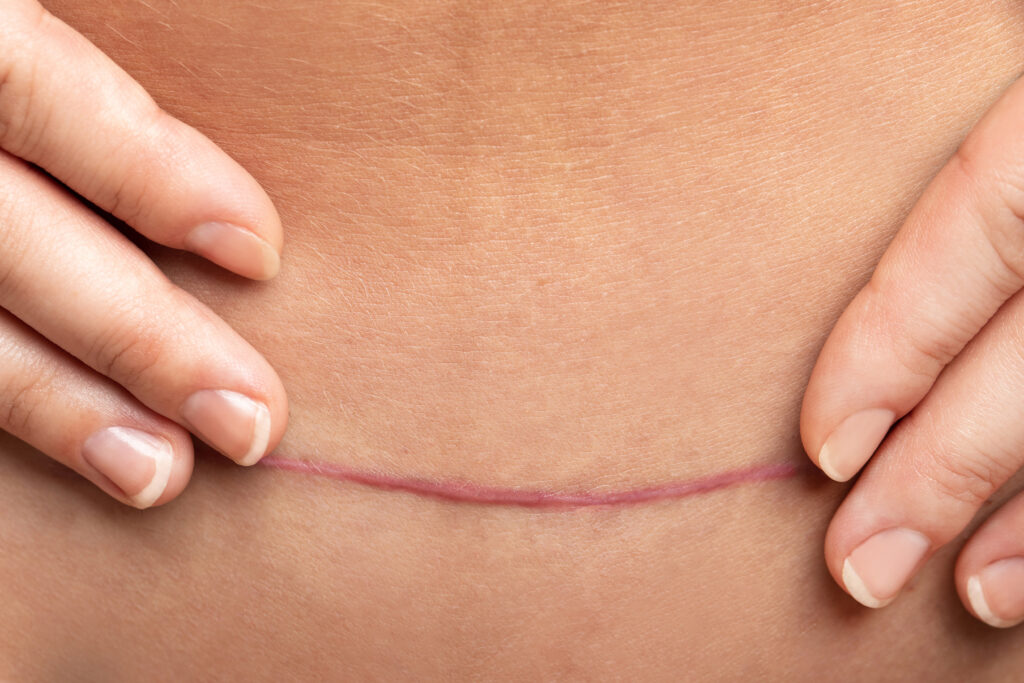A cesarean section (C-section) is a major surgical procedure that can significantly impact the body. While many women recover without complications, others may experience a variety of issues post-surgery. Hina will guide you through understanding potential C-section complications and strategies for recovery.
Common Complications After a C-Section
C-section recovery is often underestimated. Here are some of the most common complications:
- Hypersensitivity of the Abdomen: Many women experience heightened sensitivity around the incision site. Everyday actions like putting on clothes or feeling bed sheets move over the scar can cause discomfort.
- Pain During Intercourse: Despite not having a vaginal delivery, some women report experiencing pain during intercourse. This can result from changes in pelvic floor muscles or scarring.
- Back and Hip Pain: The abdominal muscles play a crucial role in supporting the lower back and hips. Surgery can weaken this support, leading to pain.
- Gastrointestinal (GI) Issues: Constipation and slow transit are common due to changes in the abdominal structure and postoperative inactivity.
Understanding the Anatomy and Surgery
To comprehend the complexity of C-section recovery, it’s helpful to understand what happens during the procedure:
- Incision: The surgeon makes an incision through the lower abdominal fascia. Although muscles aren’t cut, the fascia, a connective tissue layer, plays a vital role in abdominal integrity.
- Depth of Surgery: The procedure involves going through several layers, including adipose tissue and fascia, to access the uterus.
- Organ Manipulation: During the surgery, organs like the bladder and intestines may be moved to safely deliver the baby.
This process causes trauma to tissues, and healing may take longer than the standard eight weeks often suggested.
Interconnected Issues Post-Surgery
C-section complications often stem from how interconnected the abdominal area is with other body systems:
- Scar Sensitivity and Adhesions: Excessive scarring can affect deeper tissues, including the bladder and intestines, causing discomfort or dysfunction.
- Pelvic Floor Tightness: The fascia connects to pelvic floor muscles, which can become tight and lead to pain, including during intercourse.
- Support for the Spine and Hips: Weak abdominal fascia and muscles can contribute to instability in the lower back and sacroiliac joint, resulting in pain.
Effective Strategies for Recovery
Recovering from C-section complications requires a multi-faceted approach. Here are steps to address common issues:
1. Scar Management
Scar tissue can be a source of pain and restricted movement. Techniques like:
- Scar Massage: Helps reduce hypersensitivity and improve mobility of the tissues.
- Physical Therapy: Specialized therapies can improve scar elasticity and reduce adhesions.

2. Addressing Pain and Sensitivity
Hypersensitivity around the incision can be managed by:
- Desensitization Techniques: Gradual exposure to textures and pressures can decrease sensitivity.
- Topical Treatments: Use prescribed creams to alleviate discomfort.
3. Pelvic Floor Rehabilitation
Tight pelvic floor muscles can cause pain and other issues. Treatment options include:
- Kegel Exercises: Strengthen and relax pelvic floor muscles.
- Pelvic Floor Physical Therapy: Focused therapies to address tightness and improve function.
4. Improving GI Function
Post-surgical GI issues can be alleviated with:
- Dietary Adjustments: Increase fiber intake to combat constipation.
- Hydration: Adequate water intake supports digestion.
- Gentle Movement: Walking can help stimulate bowel function.
5. Strengthening the Core
Rebuilding abdominal strength is crucial for supporting the back and hips:
- Low-Impact Exercises: Begin with gentle activities like pelvic tilts and progress to more challenging exercises under guidance.
- Physical Therapy Programs: Tailored programs can safely rebuild strength and stability.
When to Seek Professional Help
If you experience persistent or worsening symptoms, consult a healthcare provider. Common signs that require medical attention include:
- Severe pain that does not improve
- Persistent gastrointestinal distress
- Symptoms of infection, such as fever or unusual discharge
Final Thoughts
Recovering from C-section complications takes time and the right interventions. By addressing issues like scar sensitivity, pelvic floor dysfunction, and core weakness, you can restore your body’s strength and function. If challenges persist, seek specialized care to tailor your recovery journey.
Also Read: What is Interstitial Cystitis and Painful Bladder Syndrome? Causes, Symptoms, and Treatment
About:
I’m Hina Sheth. I have been treating complex orthopedics, sports and pelvic floor physical problems for over 25 years with amazing results. Now I want to bring my knowledge to the global community so I can spread my knowledge to you.
Our bodies are complex systems of 600 muscles and organs intertwined in a fascial system that all work together. Imbalances in this system such as trigger points, visceral and myofascial restrictions can lead to joint, pelvic, and organ issues.
Factors like nutrition, exercise, sleep, and stress play a crucial role. Unfortunately, our current healthcare model does not look at our bodies as a whole and oftentimes compartmentalize musculoskeletal injuries and dysfunctions.
At Rebalance, our goal is to holistically treat this complex system to restore harmony in the body. By addressing these imbalances, we help clients improve their overall health and well-being. Our vision is to empower individuals to create a healthier lifestyle for themselves.






